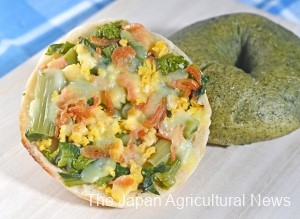CHIBA, Jan. 30 – Spring is here already on the Boso Peninsula, Chiba Prefecture. Canola flowers are in full bloom on the southern side of the peninsula in Awa, creating beautiful yellow carpets. The region is a primary producer of edible canola blossoms (nabana in Japanese) and is in the busy harvesting season.
The temperature rose to 14 degrees Celsius on the 20th of this month, and farmers were busy harvesting in the fields in Minami Boso City. They pick nabana with tight buds one by one by hand and put them in a large basket on their backs.
A local agricultural cooperative in Chiba, JA Awa, covers three cities and one town at the southern tip of the Boso Peninsula. It boasts the largest production volume of nabana in Japan. Its subcommittee of canola flower producers has approximately 600 members and shipped 431 tons in fiscal 2021.
The area facing the Pacific Ocean is warm all year round thanks to the influence of the Kuroshio Current, so farmers can grow vegetables outside even in winter.
They usually hand-pack nabana into squares using a special wooden frame to ship them in a form called ningyo-maki. The JA uses vacuum pre-coolers to cool the products evenly and quickly to deliver them fresh to the markets in Tokyo.
“This year’s nabana is very good. Please enjoy the taste of spring, which is the earliest in the Kanto region,” Hidekazu Okamoto, an 47-year-old owner of a 3-hectare nabana field, said and smiled.
In early January, the neighboring city, Kamogawa, opened Nanabatake Road, a flower garden of about 3.3 hectares, filled with 4 million canola blossoms in full bloom. You can enjoy picking flowers and the scent of nabana. Last year, the event attracted approximately 27,000 visitors. Flowers are in bloom until early March. After that, they will be green manure.
Local restaurants also join and add extra fun to the seasonal event by serving bagels, pasta, and other dishes featuring locally-produced nabana.


